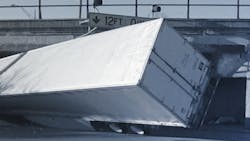Fleets eliminate bridge strikes with low-clearance technology
NASHVILLE—Two FleetOwner 500 carriers eliminated low-bridge collisions with E-Smart technology, according to new fleet reports that the company shared during Truckload 2024.
Arnold Transportation Services (FO 500: For-Hire No. 291) and Navajo Express (No. 281) reported zero bridge strike incidents since adopting the E-Smart technology, which can remotely reduce a truck’s throttle if it is approaching a bridge it would not clear.
“We're really excited about both Arnold and Navajo. They've adopted the solution, and both have been fit with E-Smart now for multiple years,” E-Smart SVP Joe Thell said during a press conference at Truckload Carrier Association’s annual convention here in Opryland.
Low-bridge strikes can cost fleets nearly $20,000
Arnold was averaging six bridge strikes per year before but has not had an incident since adopting E-Smart’s bridge strike mitigation solution, Thell said. The fleet said collision costs were about $6,000 each.
Thell said all North American bridges under 13 feet 6 inches are geofenced in its system. Using GPS, it triggers a voice alert to drivers through their ELDs if a tractor is within 750 feet of a low bridge.
See also: How the Baltimore bridge collapse impacts trucking
In addition, it alerts fleet managers and limits the vehicle throttle to idle, allowing the driver to coast to a stop or pull off the road. If the truck gets within 250 feet, the throttle is disabled. The system cannot remotely control the truck’s brakes.
During low bridge mitigation events, the driver is contacted and assisted with a safe route to exit the area. The E-Smart customer portal also allows fleets to customize alerts and monitor low-clearance bridge events in real time.
Bridge strikes were costing Navajo Express even more. The fleet said it averaged six strikes per year, costing it $18,277. Since adding the solution, its equipment hasn’t struck a bridge.
About the Author
Josh Fisher
Editor-in-Chief
Editor-in-Chief Josh Fisher has been with FleetOwner since 2017. He covers everything from modern fleet management to operational efficiency, artificial intelligence, autonomous trucking, alternative fuels and powertrains, regulations, and emerging transportation technology. Based in Maryland, he writes the Lane Shift Ahead column about the changing North American transportation landscape.

